CONTACT US
| +86-10-82600771 | |
| WhatsApp: +86-13911460247 | |
| Messenger: chinatournet | |
WeChat ID: callchinatour | |



Yungang Grottoes as a treasure house of rare and splendid
Chinese sculptures enjoys worldwide fame.
Yungang Grottoes
is located at the southern foot of Mt Wuzhou, about 16 kilometers west of Datong
City, Shanxi Province. These grottoes are the main reason most people make it to
Datong. The grottoes contain over 50,000 Buddihist statues and stretch for about
1 km east to west.
The Yungang Grottoes were first hewn in
453, the second year of the Xingan reign of the Northern Wei Dynasty, more than
1,500 years ago. Most of the principal caves had been completed by the year 495.
With its 53 existing rock caves and over 51000 statues, Yungang Grottoes is a
treasure house of ancient Buddhist art, the largest of its kind in China. It is
as famous as the Longmen Grottoes in Luoyang and Mogao Grottoes in Dunhuang,
Gansu Province.
The 53 grottoes in Yungang Grottos include
some 1,000 niches with about 51,000 statues – a treasure-trove of cave art
that combines traditional Chinese art forms with foreign influence, particularly
Greek and Indian. Sculptures here are noted for their vigorous features and rich
variety that range from the smallest, only 2 centimeters high, to the tallest
– a Buddha 17-meters high. The tallest Buddha is surrounded by many small
Buddhas in Grotto No. 5, also called the Big Buddha's
Cave.
The grottoes are composed of the following three
parts: the early rock caves (altogether five) in the west, mostly oval-shaped
and planned on a large scale, the main statue reaching the height of 17 meters;
the grottoes in the middle, oblong in shape and of two chambers, with the main
statue in the center and the walls, arches and roofs covered with Buddhist
relief sculptures; the square grottoes, each with a pagoda-shaped central
column, also excellently sculptured, attainting to the roof while the walls are
carved with niches enshrining Buddhist statues. The principal statue of the
Buddhist in Cave No.20 is 13.7 meters high and well preserved above the chest.
Executed in a well filled-out figure, the statue with vivid eyes and broad
shoulders is a representative of the sculptural art of the Yungang Grottoes.
Caves 1-4

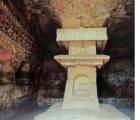
These early caves, with their characteristic square floor plan, are at the far eastern end, and are separated from the others. Caves 1 and 2 contain carved pagodas. Cave 3 is the largest in this group, although it contains only a seated Buddha flanked by two Bodhisattvas.
Caves 5-13
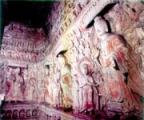

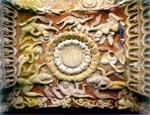
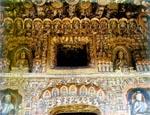
Yungang art is at its best in this group, especially in
caves 5 and 6, which boast walls of wonderfully carved Buddhist tales and
processions. Cave 5 also contains a colossal seated Buddha almost 17m high. Cave
6 contains a richly carved pagoda, and an entrance flanked by fierce guardians.
In the centre of the rear chamber stands a two-storey pagoda-pillar about 15m
high. On the lower part of the pagoda are four niches with carved images,
including one of the Maitreya Buddha(Future Buddha).Gautama Buddha's life story
from birth to his attainment of nirvana is carved in the east, south and west
walls of the cave and on two sides of the pagoda.
Caves 7
and 8 are linked and contain carvings with Hindu influences. Shiva, with
eight arms and three heads, and seated on a bull, is on one side of the entrance
to cave 8. On the other side is the multifaced Indra, perched on a peacock.
Caves 9 and 10 are notable for their front pillars and figures bearing musical
insruments. These instruments appear again in cave 12, while cave 13 has a 15m
high Buddha statue, its right hand propped upby a figurine.
Caves 16-20
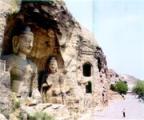

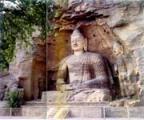

These caves were carved in about AD 460 and the Buddha in
each one represents an emperor from the Northern Wei dynasty. The Buddha in cave
18 represents Emperor Taiwu, who was once a great patron of Buddhism, but later
came to favour Taoism.
After a revolt that he blamed on
the Buddhists, Taiwu ordered the destruction of Buddhist statues, monasteries
and temples. His son is said to have died of a broken heart, having been unable
to prevent his father's atrocities, and was posthumously awarded the title of
emperor.
Taiwu's grandson Emperor Wencheng, who restored
Buddhism to the dynasty, is represented b the 14m-high seated Buddha of cave
20.
Cave 21 and onwards are small, in poor condition and
can't compare to their better preserved counterparts.
Yungang Grottoes have been damaged by both war and natural disasters over the
past 1,500 years since their completion. A special Yungang Grottoes
protection institution was set up in 1995, and in 1961, the State Council listed
Yungang Grottoes as key cultural site under its protection. In 1965, the Datong
municipal government issued and implemented the Programs for the Protection
Scope and Safety of Yungang Grottoes. From 1973 to 1976, under the instruction
of Premier Zhou Enlai, China injected a huge sum of money into the grottoes,
rescuing many grottoes and caves that had been on the verge of collapse.
Two days tour + hotel package for Yungang Grottoes in Datong city, from $174, check details...